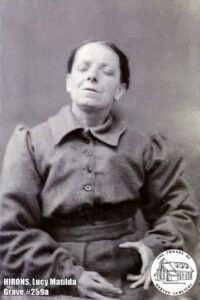b.1874 – d.1910
Parents and Norfolk background
Predominantly the Shreeve surname originates from Norfolk and Lottie’s family is no exception. Her father Leonard was born in Norwich in 1841, the son of John and Clarissa Shreeve. His father was a cordwainer or a shoemaker, a profession which Leonard followed. Lottie’s mother Hannah, born in 1842, was the daughter of Robert and Hannah Howse. Hannah’s father, too, was a shoemaker from Norwich. They married in the June quarter of 1866 in Norwich.
A Move to London
By the time of the 1871 census Leonard and Hannah had moved to Shoreditch in London and were living at 2, Norwich Road. Leonard, aged 29, was working as a “Shoe finisher” and Hannah was aged 27. They now had two young sons, Charles R, aged 2, born in Hackney and Ernest W, aged 1, also born in Hackney.
This puts their move to the metropolis around 1869.
Also, his mother Clarissa Shreeve, sister Clarissa and brother Arthur had moved to Dalston in Hackney so it appears this may have been a move from the family to find opportunities. After his marriage Arthur emigrated to Australia so the Shreeve family were open to new adventures. It also appears that by 1872 Hannah’s sister and brother were in London too.
1870s and Lottie’s birth
Lottie appears to have been born in February 1874. The only evidence we have to support this is her Birth Register entry and her school admission record. There is no baptism record that can be found but this is the same for all her siblings. They may have been baptised as non-Conformists or they are not traceable at the moment. She was the fourth child of the marriage.
Lottie was born in Norwich although by that time the Shreeve family were living in London but this is not as strange as it first appears. It could be that her family were visiting her Howse grandparents because her Grandmother Hannah Howse may have been ill as she died in the October quarter of 1874 in Bethnal Green. Hannah’s sister Harriet by that time was living in Bethnal Green so perhaps she wanted to look after their mother and took her home to London.
By 1875 the family were living at 47 Waterlow Buildings, Bethnal Green.
Research shows this to be modern improved industrial dwellings built in 1869. It was experimental model housing of its day. Quite how the family got to be there is not clear but they did not stay long as by 1876 the electoral registers show Leonard, her father, at 14 George Street, London Fields, Hackney as a Lodger. Lottie’s maternal Uncle George Robert Howse was listed as the person to whom rent was paid.
It is likely that the property was rented in George’s name but Leonard Shreeve actually lived there and paid rent to George. This property was rented by George Howse until 1881 but during this time a Charles Shreeve was also shown as a lodger at this address. How he is connected to Leonard Shreeve I have not been able to establish. He was not a close relative but he came from Norwich too so I think it is likely he was a distant relative.
1880s
On 15 August 1880 Clarissa Shreeve died aged 75. She was Lottie’s paternal Grandmother. Her address was Ash Grove in Hackney not far from George Street so it would be fair to say that Lottie would have been aware of her death. With her Shreeve Grandfather dying before she was born and her Howse Grandmother around the time of her birth, there only remained her Howse Grandfather alive in Norfolk.
The 1881 census shows the family living at 1 George Street, London Fields and Charles Shreeve is renting this property though he is not living there but at 100 Eleanor Street. There are 14 people living in 1 George Street across two households. George Street was situated in the south west corner of London Field, Hackney and by the time of Booths mapping it had been renamed Hamburg Street and was considered a mixed area with both average and poor earners. This part of Hackney was said to be very densely populated at the time with a high volume of children.
The census shows Leonard and his sister Clarissa as joint heads of the house. Clarissa is unmarried, aged 36 and working as a Machinist. Leonard is aged 39 and continuing his work as a Bootmaker. Hannah, his wife, is 38 and the children are listed as follows – Charles (12), Ernest (11), Beatrice (9), Lottie (7), Florence (5) and Eleanor (3). They are all scholars.
School admission records dated 5 September 1881 show Lottie being admitted to Shap Street school in Hackney. It shows she was previously at London Field school. Curiously her guardian is shown as a “Mrs Hows” of 83 How Street. This is the address of Lottie’s Uncle George Robert Howse. He is married but has no children, so this must be his wife Charlotte who seems to have taken on responsibility for Lottie’s education.
No other records can be found to suggest she did this for any of her other nephews and nieces.
Newspaper reports show Shap Street to be a new school built in 1878 as a Providence Chapel Mission School. At the time of Lottie’s attendance there were about 400 children and 42 teachers there. Children were encouraged to join the Tabernacle church and were “Brought up in the fear of the Lord” to quote one newspaper article of the time. What effect this had on poor little Lottie one can only imagine.
1890s
The Shreeve family certainly have problems as the next 2 decades will show. On 7 August 1890 Lottie’s eldest brother Charles Robert Shreeve aged 21 was admitted to Cane Hill or Coulsdon asylum in Surrey. This was the third Surrey County pauper lunatic asylum passed to London County Council in 1889. There was no earlier indication in the records to suggest there were issues but he stayed at the Asylum until 12 September 1893 when he was relieved from Cane Hill but not recovered.
It appears from the Chelsea Pensioner records that Charles Robert Shreeve enlisted in 1890 to the Royal Lancaster Regiment prior to his admission into the asylum. The entries in the 1891 and 1901 census support this by describing his occupation as a soldier.
There is evidence that he may not have ever returned home as the 1901 census shows he was a patient at Claybury Asylum, London’s 5th Asylum, at Woodford Bridge. There is a further Lunatic Register entry for him showing he was again admitted to Cane Hill Asylum on 3 September 1907 where he died on 26 April 1914. It certainly seems he never recovered from his troubles.
The family suffered another blow when on 6th January 1891 poor Lottie was admitted to Colney Heath Asylum aged nearly 17. On looking through the Census entries for the Asylum in the April of that year it shows she is one of the youngest patients and there are very few girls of her age incarcerated there. Colney Heath was very overcrowded and had a terrible reputation as the staff struggled to cope with the numbers. It must have been awful for a young woman. Fortunately, she was only there for 9 months and she was discharged back to the family on 11 September 1891, the records stating she was recovered.
The family census entry in April 1891 therefore missed both Charles and Lottie as they were both shockingly in Asylums. This must have been traumatic for the family.
The Shreeve family were now living at 12 Homerton Terrace in Hackney which was considered by Booth to be a mixed area. There were 10 people living at the address which was made up of 2 households. From the Electoral Registers we see that they were there for at least the next 5 years. Leonard is head of the household, aged 49 and working as a Boot Finisher. Hannah, aged 47, has no occupation and of the remaining children Ernest Walter (21) is a Boot Cutter, Beatrice (19) is a Tailoress, Florence (15) is a Boot Cutter and Eleanor (13) is a scholar.
There is no further information until an entry in the 1897 electoral register showing the family living at 6 Williams Cottages which was off Eleanor Road in Hackney.
1900s
By 1901 the family were renting 183, Richmond Road in Hackney which was considered a “well to do” area in St Philip’s parish, Dalston. The Electoral Register shows the family were renting 4 Rooms, a basement room and 3 first floor rooms unfurnished for 10 shillings a week. The whole property seems to have been rented by an Edward Loader. This man was Leonard’s new son-in-law. Beatrice Shreeves had married Edward, the son of an undertaker, on 25 December 1897.
The census entry shows who was living at the property in April 1901:
- Leonard Shreeve, head, aged 59, a shoe maker
- Hannah, aged 58, no occupation
Their children are listed as
- Ernest (30) a Boot Clicker (A person who cuts all the pieces for the top of a shoe or boot)
- Lottie (27) a Tailoress
- Florence (25) a paste fitter Boot Trade (She would have pasted together all the leather parts cut out by her father and brother)
- Eleanor (23) also a Tailoress.
Beatrice is living there aged 28 with her husband Edward Loader (35) who is a Commercial Clerk. Another family of 3 people were living in the other rooms paying rent to Edward Loader.
A joyous family occasion
On 14th August 1902 there was great joy for the family when Lottie’s younger sisters Florence and Eleanor had a double wedding at St Philips church Dalston. Florence married Frederick Gapp and Eleanor married William Mason. A newspaper article gives us a wonderful glimpse of the day which included Lottie who was one of 4 bridesmaids to her sisters. It tells us she wore a heliotrope (purple) and white delaine dress with a black picture hat, her bouquet had white lilies and yellow marguerites and she received a gift of a gold wishbone brooch with red rubies from the bridegrooms. One hopes she had a wonderful day. Her father is described as an old and well-known resident of Richmond Road. There were many guests with the reception taking place at number 183 and we even know photographs were taken. A great day for all the family.
A change in the family’s fortunes
Fortunes turn again when Lottie’s Uncle George Howse suffers some kind of mental trauma. For many years he and his wife had lived at 83, How Street. George was also a Boot Cutter or Clicker. They had no children. The Settlement Papers state that on 30 May 1904 George was taken by the Police to Shoreditch Infirmary being alleged to be of an unsound mind. He was examined on that day and was found by the Doctor to be as follows –
“He is very excitable, lost to his surroundings, forgetful, abusive, uses filthy language, threatened the attendant, thinks he is persecuted, states people are looking at him through the window. He uses irrelevant answers to questions”.
Charlotte his wife testifies that he raves and talks foolishly, writes silly letters and possesses a knife and that he said she wanted people killing and threatened to cut his own throat.
It seems he had been like this for a couple of weeks. It is here that it is confirmed he has a nephew in Claybury Asylum (Charles Shreeve). The decision was made that he is a person who should be dealt with under the Lunacy Act.
So, on 4 June the papers are signed confirming he is a pauper receiving relief and that he is “a Lunatic wandering at large”. He is therefore to be sent to Bexley Asylum. On the 6 June 1904 he is received at Bexley Asylum and is reported to be “clean” but his bodily condition was “poor”. Interestingly he has “a large scar over his occipital region”. This is at the back of the head. Did he receive an injury to the brain at some point? Could this account for his behaviour?
Poor Uncle George did not survive long and he died on 30 January 1905 at Bexley Asylum.
Did this have an effect on Lottie? We can never be sure but there is certainly a decline in her mental welfare and on 15 May 1905 aged 30 she is admitted to Horton Hospital. There are at present no records to know why but this time there is no recovery and she spent 5 long years there before she died on 30 August 1910 and is buried in Grave 851b on 5 September 1910.
Author’s Thoughts
Lottie was born to a family who seemed immersed in the Boot making trade who came to London along with a number of close family members probably for better money and opportunities. They supported each other within the trade and always seemed gainfully employed.
What is striking for Lottie is that at the age 8 her aunt seems to take responsibility for her education. She is singled out and sent to a school connected to the church where the children were “brought up to be in fear of God”. Why was she singled out from her siblings? Perhaps she was a favourite of her childless Aunt or were there signs that all was not well?
Both Lottie and her older brother enter Asylums within 6 months of each other. Was there something hereditary or perhaps darker undertones of something within the family? Charles was 21 when he was admitted to Cane Hill and evidence seems to suggest he never recovered. Lottie was more fortunate as she seemed to recover after 9 months and was discharged from the awful Colney Heath and lived and worked in the bosom of her family for another 14 years. We get a glimpse of her having a happy day as bridesmaid for her younger sisters in 1902.
Then there was poor Uncle George, her maternal Uncle who went into a mental decline in 1904 and died committed as “a Lunatic, a danger to others”. How on earth did that affect her? Did this trigger her decline? Is it a coincidence that shortly after his death she is admitted to Horton Hospital and sadly that is where she remains until her death. The third person in her family to end their days in one of London’s County Asylums. This must have been hard to bear for all the family who had more than their fair share of experiences with these institutions. Not one of these poor souls could be saved.




